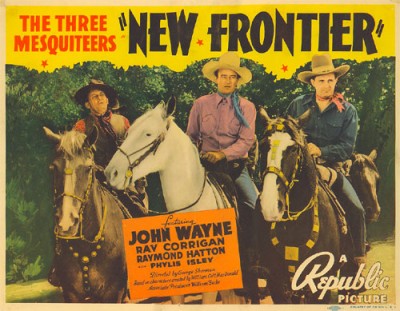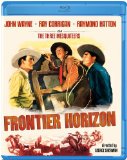| Reviews & Columns |
|
Reviews DVD TV on DVD Blu-ray 4K UHD International DVDs In Theaters Reviews by Studio Video Games Features Collector Series DVDs Easter Egg Database Interviews DVD Talk Radio Feature Articles Columns Anime Talk DVD Savant Horror DVDs The M.O.D. Squad Art House HD Talk Silent DVD
|
DVD Talk Forum |
|
|
| Resources |
|
DVD Price Search Customer Service #'s RCE Info Links |
|
Columns
|
|
|
Frontier Horizon (New Frontier)
The picture is also remembered as actress Jennifer Jones's first, though she's billed here under her birth name, Phylis Isley. She plays the stereotypical prairie flower, but Jones's beauty and screen presence leave little doubt that she's destined for bigger and better things. Stardom and a Best Actress Academy Award were just four years away.
The box art calls this Frontier Horizon but the actual title onscreen is New Frontier. This is to avoid confusion with another, far superior Republic-John Wayne movie of the same title, released three years earlier. Frontier Horizon may have been its television syndication title but, even though the video transfer sources (1953?) reissue film elements, the title onscreen remains New Frontier. Curiously, the reissue version doesn't bother to redo the credits to reflect Jennifer Jones's name change and stardom. And while this is sometimes erroneously credited as a remake of The New Frontier, their plots are in fact dissimilar.
As with Olive Films' other two '30s John Wayne titles in this wave and the three released to Blu-ray before that, the video transfer is impeccable. It sources quite a lot of grainy stock footage - the opening even appears to be D.W. Griffith's battle footage from 1915's The Birth of a Nation! - the rest of the picture is very impressively clean and razor-sharp.
Republic's Westerns often played fast and loose with American West history, but New Frontier/Frontier Horizon is especially loopy in this regard. Immediately after the Civil War, Major Steven Braddock (Eddy Waller) and his wife move out west where he founds the idyllic community of New Hope. Braddock looks to be about 50 at this point but a full half-century later, is on hand for New Hope's Anniversary Jubilee appearing a very spry 65 or so, a long way from 100. This would also set the bulk of the film around 1915-16, but John Wayne, Ray "Crash" Corrigan, and Raymond Hatton (replacing Max Terhune), as Stony Brooke, Tucson Smith, and Rusty Joslin, play Pony Express riders, which stopped delivering mail in 1861.
Further, while at a protracted grange dance the women all wear 19th century period costumes, later on they sport contemporary clothes as well as distinctly 1930s hairstyles and makeup. The townsfolk all ride buckboards and covered wagons even though automobiles were a common sight even out West by 1915. At one point the Mesquiteers are shown a film on a 16mm projector (whose reels don't move), but that film gauge wasn't introduced until 1923.
But most anachronistic of all is the proliferation of telephone poles and very modern looking electrical towers. Westerns shooting in the rolling valleys and rocky hills northwest of Los Angeles often had to film around such things and didn't always succeed in hiding them (the TV series M*A*S*H, set in 1950-53 Korea but filmed in Malibu, encountered similar challenges) but in New Frontier there are sequences where highly visible modern electrical towers practically dominate every shot. If one made a drinking game out of this everyone would be juiced after the first two reels.
Regardless, at the height of New Hope's jubilation, with Braddock leading a prayer asking God to keep everything as wonderful as it is, "if it's not too much to ask," word arrives that the entire town has been condemned by the state, to flood it to facilitate a reservoir for use by a big city nearby, Metropole. Bitterly the townsfolk tear up checks issued to buy up their land. M.C. Gilbert (perennial bad guy LeRoy Mason), assigned the job of building the dam, orders his henchmen to drive the citizens of New Hope from their homes. Meanwhile, Assemblyman Proctor (Harrison Greene) uses the decision against the homeowners to sell them worthless land with the empty promises of building them a water pipeline. You'd have thought that the land's name, "Devil's Acres," would have tipped them off.
Even at 55 minutes, New Frontier feels awfully padded. Besides the overlong grange dance, action scenes are supplemented with loads of stock footage, while the wagon drive prologue is extended with yet more stock, possibly from The Big Trail (1930), Wayne's first starring film. The picture seems to be leading up to a climatic dam burst similar to Gene Autry's later The Singing Hill (1941), also for Republic, but instead everything comes to a head at a not very impressive real dam barely 10 feet tall and perhaps 50 feet across.
Video & Audio
Minor as New Frontier/Frontier Horizon is, Olive's video transfer is impeccable, and it's great to see even this looking so sparklingly good. The black-and-white, 1.37:1 image is pristine, with only minor imperfections inherent to the original film elements. Detail, blacks, and contrast are all very impressive. The Region A disc has decent audio, English only with no subtitle options, and No Extra Features.
Parting Thoughts
Feeble but fascinating for capturing John Wayne and Jennifer Jones at the crossroads of their careers, New Frontier/Frontier Horizon is still worth a look, especially since what there is to look at is so terrifically crystal-clear. Recommended.
Stuart Galbraith IV is a Kyoto-based film historian whose work includes film history books, DVD and Blu-ray audio commentaries and special features. Visit Stuart's Cine Blogarama here.
|
| Popular Reviews |
| Sponsored Links |
|
|
| Sponsored Links |
|
|
| Release List | Reviews | Shop | Newsletter | Forum | DVD Giveaways | Blu-Ray | Advertise |
|
Copyright 2024 DVDTalk.com All Rights Reserved. Legal Info, Privacy Policy, Terms of Use,
Manage Preferences,
Your Privacy Choices | |||||||















